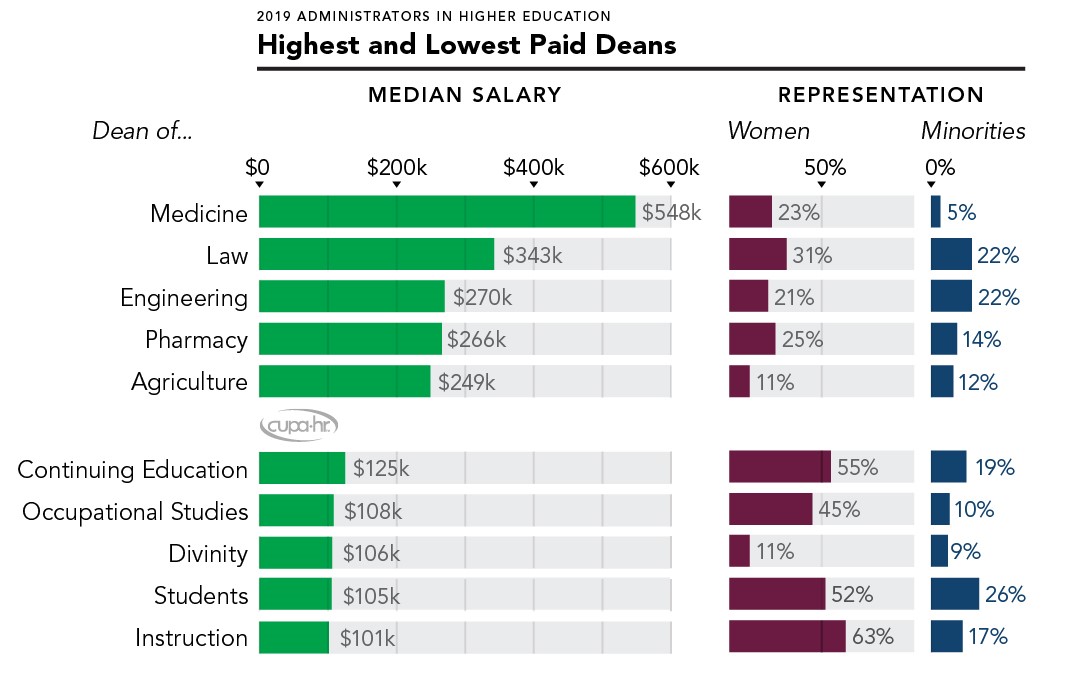PRESS RELEASE
FOR IMMEDIATE RELEASE
April 24, 2019
Women and Minorities Lack Representation Among Highest-Paid Deans
Women are better represented among deans with the lowest salaries, but they make up less than one-third of any of the highest-paid deans, according to the 2019 CUPA-HR Administrators in Higher Education Report released today. The top five highest-paid dean positions combined have 20 percent female representation, whereas the five lowest-paid dean positions combined are 47 percent female.
Representation of racial/ethnic minorities among deans also varies. The highest-paid dean position, dean of medicine, has the lowest representation of racial/ethnic minorities among all 42 dean positions surveyed. In contrast, minorities make up more than one-quarter of deans of students, which is one of the lowest-paid dean positions.

Among academic deans, women of color are sometimes compensated much less than or much more than their White male counterparts, depending on the discipline. Black and Hispanic women are paid only $0.68 for dean of health-related professions and only $0.73 for dean of continuing education positions compared to White men, but earn $1.07 and $1.14 per White male dollar for dean of students and dean of law positions, respectively.
About two-thirds (65 percent) of all associate/assistant deans have faculty status, earning higher salaries than those without faculty status in all but seven disciplines: agriculture, continuing education, library sciences, music, performing arts, social sciences and veterinary medicine.
Other findings from the CUPA-HR 2019 Administrators in Higher Education Annual Report include:
- Administrator salaries increased by 2.7 percent for the 2018-19 academic year. The highest raises went to senior institutional officers (those who direct major functional areas) (2.8 percent), and the lowest went to top executives (2.0 percent) and associate/assistant deans (2.0 percent).
- Women continue to make up about half (51 percent) of all administrators, the same as last year, and the percentage of racial/ethnic minority administrators has risen slightly to 16 percent this year, up from 15 percent last year.
- Some top administrative roles, such as chief diversity officer, employ a large percentage of Black and Hispanic women (52 percent), whereas other positions, such as chief facilities officer, are overwhelmingly occupied by White men (83 percent).
- The median age for higher education administrators is 54 years old, and nearly nine in 10 administrators are between the ages of 40 and 70.
- The number of institutions offering performance-based incentives increased this year, and fewer institutions are now offering deferred compensation as an executive benefit.
A total of 1,174 higher education institutions provided incumbent-level data for 50,880 administrators in 200 positions for this year’s survey. The survey collects data on salaries and demographics for each individual incumbent, allowing for more in-depth analysis and comprehensive benchmarking. Data collected include salary, sex, race/ethnicity, age, years in position and faculty status (for associate/assistant deans.)
To learn more about the Administrators in Higher Education Survey, read the overview. Salaries, demographic comparisons and detailed trend information are available in the full report.
About CUPA-HR
CUPA-HR is the recognized authority on compensation surveys for higher education, with its salary surveys designed by higher ed HR professionals for higher ed HR professionals and other campus leaders. This marks CUPA-HR’s 52nd year of data collection on higher education administrators, the longest-running of CUPA-HR’s surveys. Learn more about CUPA-HR research.
CUPA-HR is higher ed HR. We serve higher education by providing the knowledge, resources, advocacy and connections to achieve organizational and workforce excellence. Headquartered in Knoxville, Tennessee, and serving over 31,000 HR professionals and other campus leaders at more than 2,000 member institutions and organizations around the country and abroad, the association offers learning and professional development programs, higher education salary and benefits data, extensive online resources and just-in-time regulatory and legislative information.
Contact Information
Erin Rosolina
Marketing Manager – Communications and Marketing
[email protected]


